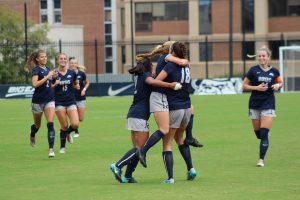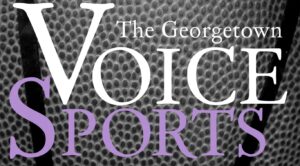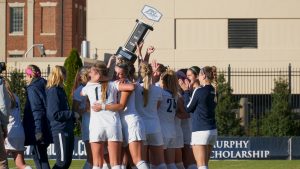Georgetown football is an anomaly among sports on the Hilltop.
The Hoyas have never won a conference championship in the near quarter-century it has been a member of its conference, the Patriot League. Nor has Georgetown ever made the 24-team Division I Football Championship Subdivision (FCS) postseason tournament. Many people don’t even know that Georgetown has a football team. Nowadays, the team never sees much success or fan engagement, despite usually winning a handful of games each season.
A quick search into the history of the Hoyas on the gridiron reveals a rich and colorful team which, at times, was quite successful. The Georgetown football team was consistently ranked in the AP Poll from 1938 to 1940, and even made the Orange Bowl in 1941 where the No. 13 ranked Hoyas lost to No. 9 Mississippi State 14-7.
John Reagan (MSB ‘84) began researching the history of the team in 2003 to digitize its past and fill gaps in its historical record. Twenty years later, his website, hoyafootball.com, documents the schedules and team rosters of Georgetown football going all the way back to 1887.
The product of this research is a complete view on Georgetown, one of the most dynamic teams in the history of college football, and how this team, once ranked in the AP Top 10, was torn down and rebuilt once more.
Beginning of the end
The decline of Georgetown football truly began after World War II, when the Hoya fanbase collapsed due to several factors which, when combined with the rising costs of running the team, made shutting down Hoya football the only possible option.
From 1925 to 1950, Georgetown played their home games at Griffith Stadium, a major league baseball park with a capacity of around 30,000 people located near Howard University.
But Griffith Stadium was also home to George Washington University’s football team, the MLB’s Washington Senators, the NFL team now called the Washington Commanders, as well as Maryland’s football team for a brief period while the Terrapins were rebuilding their stadium in College Park.
Consequently, multiple teams were fighting over the expensive weekend slots at Griffith Stadium. In an effort to save money, Georgetown games moved from the traditional Saturday afternoon to Friday nights, and D.C. didn’t respond well to that.
“Friday night was for going out with family, or there might be a high school event of some kind,” Reagan said. “So attendance began to drop off.”
Attendance wasn’t the only thing that declined as a result of switching to Friday games. Since college football is typically played on Saturdays, D.C. area newspapers would have game recaps printed in the Sunday paper. Georgetown’s football team, having played a day prior, was literally yesterday’s news, so the papers only mentioned the Hoyas lightly, if at all. As a result, Georgetown football began to evaporate from the public consciousness.
A handful of these fans likely switched their allegiance to other universities, typically larger state schools like Maryland or Virginia. After World War II, the G.I. Bill guaranteed a college education for American soldiers, so college enrollment exploded. While a handful of these veterans did enroll in private schools like Georgetown, the majority enrolled at large state schools around the country, which brought these new students and their families into the football fandom of these schools.
But even the growth of state schools’ football teams couldn’t match the biggest football juggernaut of the era. With Georgetown football out of many Washingtonians’ minds by the late 1940s, D.C. football fans turned to the fastest-growing phenomenon in the sport: the NFL.
In short, Washington’s NFL team took off in the 1940s. They won the 1940 NFL championship and, as a result, football fans began to gravitate toward the pros. The growth of the NFL didn’t just affect college football in the District, either. College teams in New York, such as NYU and St. John’s, also began to decline as a result of the growing popularity of the New York Giants. It’s no coincidence that the major cities in the Northeast, where college football is the least popular today, played host to many of the original NFL teams.
By 1950, attendance had dropped to the point where the football team was running an unavoidable deficit, so Georgetown President J. Hunter Guthrie made the decision to cut football entirely, effective in 1951.
Georgetown wasn’t the only relatively small, academically oriented private school looking to keep athletic costs down. Numerous schools like Stanford, Northwestern, Duke, and Vanderbilt faced high athletic costs and were overshadowed by larger public universities, and yet those programs survived to the modern day and play in some of college football’s most popular conferences.
Despite the many similarities, those schools had two major things that Georgetown lacked: on-campus facilities and passionate rivalries.
All of these schools constructed on-campus stadiums that seated tens of thousands of fans in the 1920s, which meant that ticket revenue stayed in-house. Georgetown, on the other hand, had to pay to use Griffith Stadium.
These teams also had fierce rivalries with other schools which guaranteed at least a game or two with a filled stadium every year, even if the team itself wasn’t performing well. For example, every year Stanford plays Cal in the “Big Game,” one of college football’s most historic rivalries which has gifted fans many great moments in the sport, including the famous “Band is on the Field” moment in 1982.
Duke-North Carolina, Northwestern-Illinois, and Vanderbilt-Tennessee are all rivalries with regional interest, each guaranteed to have paying spectators. Even the Ivy League has fierce football rivalry, with Harvard and Yale playing each other annually since 1875.
Georgetown, on the other hand, never scheduled consistent opponents, and as a result, rivalries that could have potentially occupied the minds of students and fans for decades never formed. After World War II, the athletic department regularly scheduled teams like Tulsa, Miami (Fla.), and Detroit (modern-day Detroit Mercy).
“These teams had no relevance to somebody in Washington, D.C.,” Reagan said. “We weren’t playing Virginia. We were not playing Temple anymore. We were not playing West Virginia anymore. These seemed to be a haphazard group of schools, so the ties that bind weren’t there.”
Perhaps, if the school had built Cooper Field a hundred years earlier and had developed a passionate rivalry against a nearby state school like Maryland, Virginia, or Virginia Tech, Georgetown could be a football powerhouse today.
Modern football woes
By the 1960s students and alumni, well aware of the past glory of Hoya football, began efforts to bring football back to the Hilltop. A club team was formed in 1964 before the administration, noticing the popularity of the sport, brought the team back to the NCAA ranks in 1970, first as a non-scholarship Division II program before settling in Division III, playing the likes of Catholic University and Gallaudet University.
But in 1992, the NCAA decided that colleges must be in the same NCAA division for all sports. Since Georgetown basketball was Division I, the athletic department faced a decision: cut football again, or bring Georgetown football to Division I. They chose the latter, and the Hoyas, alongside 26 other D-III programs, made the move upward to the FCS level of D-I.
They joined the Metro Atlantic Athletic Conference and played alongside teams like Iona, Canisius, Siena, Fairfield, and LaSalle. And the Hoyas were respectable, winning conference titles in 1997 and 1998.
But the Hoyas, like in the 1940s, were once again facing attendance issues, and the athletic department thought the problem had to do with Georgetown’s opponents.
Canisius and Siena weren’t enticing opponents. “They were not peers,” Reagan said. They had no connection to Georgetown. The team turned their eyes to schools which were a better fit both academically and athletically.
They joined the Patriot League in 2001, which brought Georgetown in line with other football-playing Catholic schools in the Northeast like Fordham and Holy Cross. Soon after, Georgetown started playing some Ivy League schools in non-conference play.
“The real pitch that was made by [the football coach at the time], was that we could have an experience in the fall where students and alumni and parents could be on campus for a peer institution,” Reagan said. “But the Ivies don’t look at Georgetown as a peer.”
One advantage of the Patriot League was that the winner of the conference earned an automatic spot in the FCS postseason tournament for a shot at the FCS national championship. After more than two decades in the league, however, Georgetown has never won the Patriot League, let alone appeared in the tournament.
Then, in 2010, the Patriot League did the unthinkable: they began to allow scholarships for football, and every team in the league began to offer 60 football scholarships. That is, every team except for one: Georgetown.
“I think at one point I said, ’this is going to end poorly.’ Because we can’t compete,” Reagan said. “A zero scholarship team can’t compete against a 60 scholarship program.”
And yet this massive transition in the rules of Georgetown’s conference surprisingly had little effect on Georgetown’s performance in the league.
“For the most part, what all the Patriot League schools were doing, except for Georgetown, was moving money from the financial aid office to the athletic department,” Reagan said. “The quality of their athletes had not changed considerably, so Georgetown could still compete with them.”
While the athletic ability of Patriot League football players didn’t change much after 2010, Reagan pointed out that the shift cemented the inability for Georgetown football to recruit ‘middle-class’ athletes.
“Georgetown can, admissions-wise, draw kids from the upper income because they want to be there. It can draw kids from the lower income because of need-based financial aid,” Reagan said. But the story for potential recruits in between these groups raises a problem for Georgetown’s football team in the long term.
“If I’ve got to pay $35,000 to go to Georgetown and Lehigh gives me a free ride, for some people Lehigh becomes a really good offer.”
And that brings us to the 2024 season, the Hoyas’ 24th season in the Patriot League, and 14th in which the conference allows football scholarships.
The road ahead will only get tougher for the program. Next year, frequent FCS playoff team and 2008 national champion Richmond Spiders are joining the Patriot League, increasing the total number of teams in the conference to eight and further reducing Georgetown’s chance of being successful in the league.
Another change may be in store for Georgetown football. The administration has shown in the past that it is open to reviving football’s relevance on campus, as long as it never crosses the line of making football a scholarship sport.
Perhaps Georgetown could join the Pioneer League, a non-scholarship league with teams across the country, including Catholic peers like Dayton and Hoya basketball rival Butler. Maybe then the Hoyas could earn a berth in the FCS tournament.
Alas, we are just living in another chapter of the dynamic history of Georgetown football, one that has changed forms numerous times in years past and, given that we now live in the era of NIL and conference realignment, may continue to evolve in the future.





